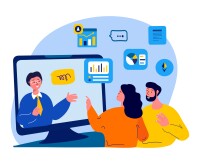Search
There are 20 results.
Tag
Tag
All (20)
Analytics (1)
Assessments (3)
Asynchrony (3)
Authentic Activities (1)
Backwards Design (1)
Canvas (1)
Case Studies (2)
Collaboration (2)
Communication (4)
Community (2)
Copyright (1)
Course Maintenance (1)
Course Preparation (3)
Discussions (1)
Faculty Presence (1)
Feedback (1)
Learning Objectives (3)
Multimodality (4)
Qualitative courses (1)
Quantitative courses (1)
Summative Assessments (1)
Synchrony (4)
Third-Party Tools (1)
Case Study Best Practices Guide
Case studies are an effective and powerful pedagogical tool. They present realistic narratives to students and require them to analyze possible outcomes or solve a dilemma or challenge associated with the narrative, and they are often followed by a series of questions or prompts that ask students to demonstrate their learning. Case studies can be based on real-world situations or fictional scenarios modeled on authentic occurrences. Regardless of the source and format, case studies provide students an opportunity to practice solving problems that they might encounter in the future.
Case Studies in a Multimodal Course
Case-based learning allows students to develop higher-order critical thinking, problem-solving, synthesis, analysis, and communication skills by engaging with a realistic scenario in service of practicing course skills and concepts. Case studies are valuable tools for any class that combines asynchronous and synchronous learning. Indeed, some research (e.g., Webb, Gill, & Poe, 2005) suggests that a multimodal delivery model may be ideal for case study-based work, with the combination of synchronous and asynchronous elements enabling students to participate more fully in cases. In the first half of this piece, we outline some key considerations for using case studies in a multimodal course. In the second half, we make targeted recommendations for effectively prepping, facilitating, and reflecting on your multimodal case studies.
Problem-Based Learning
Problem Based Learning is a teaching method used to facilitate student knowledge acquisition. This teaching method is often confused with Project Based Learning, which centers on students applying knowledge. The focus of Problem Based Learning is students acquiring the knowledge. Since the two methods use the same acronym, they are easily confused, but have different objectives for students.
Project-Based Learning
Project-based learning is learning that is organized around a project (Bell, 2010). It is a student-centered approach to learning, where students choose their topic of study and design an integrative project around the topic (Bell, 2010; Astawa et al., 2017). This form of study promotes self-efficacy in the learning environment. Such self-efficacy enables students to perform more difficult tasks and develop confidence in their abilities (Shin, 2018). These abilities generally help students to transfer their skills to the real world.
Inheriting an Online Course
Over the course of your teaching career, you may inherit an online course developed by another faculty member. While such a situation can offer many advantages, it can also provoke many questions and pose significant challenges. Inheriting a complete course with materials and assessments already in place can simplify and streamline some aspects of instruction, but it can be difficult to identify where to start and what to prioritize as you begin engaging with the course. This blog outlines a four-phase process that can lead to a successful transition.
Backward Design
Backward design is, as the name suggests, a process for designing curricula, courses, and lectures by working backwards from big-picture learning goals. The concept, introduced by Grant Wiggins and Jay McTighe (2005), suggests that instructors create assessments, activities, and course content that are explicitly aligned with the broader learning goals of the unit. This is different from the traditional content-driven approach to learning design, which focuses on course content first and only secondarily tries to align that content with learning goals.
Easy and Essential Online Course Elements
Transferring your course online opens a world of possibilities. In fact, you might be tempted to spend hours trying to locate and learn new educational technologies, or to rebuild your entire course in the learning management system (LMS). But while effective use of technology can certainly enhance learning experiences, it can also introduce obstacles for both faculty and students.
Creating Learning Objectives
Learning objectives help inform students about what they will learn and how they will be assessed. Objectives are meant to align with course expectations. Therefore, any assigned exercises should be guided by the course’s specific learning objectives. Everything in the course should work together to ensure students master the course objectives.
Copyright
From time to time instructors may want to include in their courses copyrighted materials like images, print content, audio recordings, or videos. The University of Minnesota Libraries define copyright as “the area of law that deals with creation, ownership, sale, and use of creative and expressive works.”
Multimodal Models
Designing a successful multimodal course means, at each step of the process, considering what each format does well—structuring the course such that each piece of content, each activity, each interaction uses the most effective delivery method available. But what does that look like in practice? This piece describes three approaches to structuring a multimodal course. In each model, asynchronous and synchronous time complement one another and further module and course objectives. Where the models differ is in the relative importance of asynchronous activities in enabling students to complete synchronous activities and vice versa.










